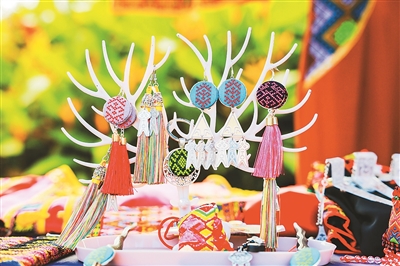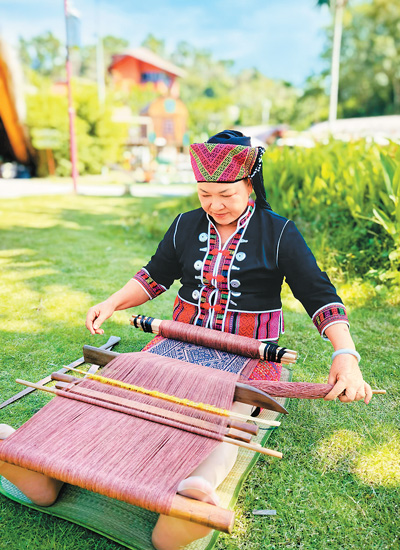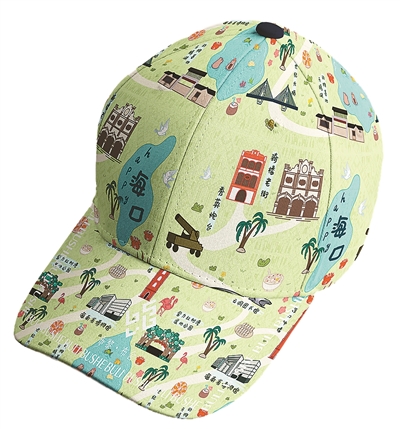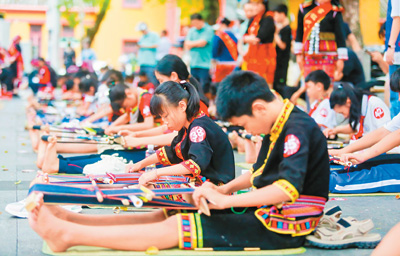Li brocade well inherited, gains international fame

Photo shows creative cultural products featuring elements of Li brocade. (Photo courtesy of the Publicity Department of the Communist Party of China Wuzhishan Municipal Committee)
Recently, a performance featuring singing and demonstration of Li brocade, the traditional textile of the Li ethnic group, was held in Maona village, Shuiman town, Wuzhishan city, south China's Hainan Province, giving tourists a firsthand look at the complete process of creating Li brocade.
The United Nations Educational, Scientific and Cultural Organization (UNESCO) recently added the traditional Li textile techniques to its Representative List of the Intangible Cultural Heritage of Humanity.
As a child, Liu Xianglan, a resident of Fanna village in Wuzhishan, was captivated by the vibrant colors and intricate patterns of Li brocade. At 55 years old, she still maintains the enthusiasm of her youth when talking about the traditional craft.

Liu Xianglan demonstrates the craft of Li brocade. (People's Daily Overseas Edition/Zhou Yajun)
Li brocade is known as the "living fossil" of the textile industry. People of the Li ethnic group started to use natural fibers such as cotton and flax to make clothes as early as 3,000 years ago.
Liu, a skilled Li brocade artisan, explains that the Li ethnic group lacks a written language, making Li brocade a vital carrier of their culture, customs, and beliefs. Each piece of Li brocade conveys a unique story.
In 2006, the traditional Li textile techniques were recognized as an intangible cultural heritage in China. In 2009, the UNESCO recognized the traditional Li textile techniques of spinning, dyeing, weaving, and embroidering as urgently needing safeguarding, placing them on the List of Intangible Cultural Heritage. Liu was recognized as a national-level intangible cultural heritage inheritor in the same year.

Photo shows a Li brocade hat designed by Chen Mengli. (Photo courtesy of Chen Mengli)
Over the centuries, the art of Li brocade has been passed down through generations by word of mouth and hand. The products were mainly used for personal use, as dowries, or as gifts for relatives and friends. With urbanization, people's lifestyles and clothing habits changed, and industrial ready-made clothes replaced hand-woven fabrics. The younger generation's interest in Li brocade decreased, leading to the decline of this traditional craft.
However, Liu never threw in the towel when it came to Li brocade. Back in the 1980s, she saw the special charm of the craft. Tourists frequently flocked to the Li village, and one day, as she sat weaving brocade with a few other women under a thatched roof, they drew the gaze of many spectators. Liu elucidated the meaning behind the intricate patterns of Li brocade to the tourists. Enthralled by the exquisite belt she was crafting, a tourist decided to purchase it.
In 2007, Liu founded a Li brocade weaving cooperative, rallying women in the village to join forces. With support from the government and social organizations, the cooperative's business thrived, expanding from eight to 16 embroiderers, and now boasting a team of 63. The product range also diversified, encompassing scarves, backpacks, clothing, mouse pads, sachets, and more.
Liu broke tradition by teaching her son the craft of weaving Li brocade. Her grandson, Wang Chengye, began learning at 3 years old and mastered multiple patterns when he was 8. In 2009, the Hainan Minzu Technical School initiated a Li brocade teaching program, inviting Liu to teach. In 2013, schools in Wuzhishan started to introduce Li brocade courses with Liu as the instructor.

Children compete during a contest on Li brocade and Miao embroidery in Wuzhishan city, south China's Hainan Province. (Photo courtesy of the Publicity Department of the Communist Party of China Wuzhishan Municipal Committee)
Chen Mengli, a student of Liu, became a municipal-level intangible cultural heritage inheritor after 10 years of learning the craft. She studied fashion design in college and combined traditional Li brocade with modern design. In 2021, she showcased 35 sets of Li brocade clothing during the Hainan Island Fashion Week.
In recent years, Wuzhishan has enhanced Li brocade talent training, establishing a three-tier intangible cultural heritage list system. The city now has 66 representative Li brocade inheritors, with over 3,500 people mastering the craft. Intangible cultural heritage workshops are thriving, and the Li brocade industrial chain is maturing, contributing to rural revitalization.

A model wearing Li brocade clothing walks the runway during the Paris Fashion Week in Paris, France, on Sept. 27, 2024. (Photo/Sun Zhenlai)
Today, village fashion shows have become a new platform to showcase Li brocade. Models in Li brocade attire walk the runway to the tune of Li ethnic songs, exuding youthful energy and style. They also promote local agricultural products like wine, honey, and tropical fruits.
Li brocade is gaining international recognition. Since 2023, Wuzhishan has sent intangible cultural heritage talents to Italy, Singapore, Malaysia, Japan, and more to showcase Li brocade culture. In September 2024, Li brocade made its debut at the Paris Fashion Week, capturing the attention of the global fashion industry.
Photos
Related Stories
Copyright © 2024 People's Daily Online. All Rights Reserved.









